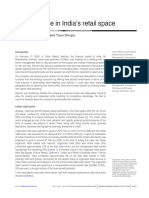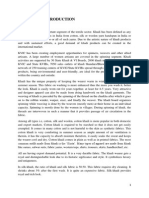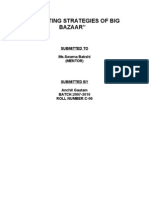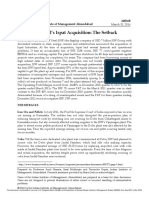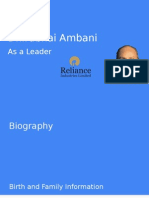Overview of Indian Retail Industry
Overview of Indian Retail Industry
Uploaded by
Purva AgrawalCopyright:
Available Formats
Overview of Indian Retail Industry
Overview of Indian Retail Industry
Uploaded by
Purva AgrawalCopyright
Available Formats
Share this document
Did you find this document useful?
Is this content inappropriate?
Copyright:
Available Formats
Overview of Indian Retail Industry
Overview of Indian Retail Industry
Uploaded by
Purva AgrawalCopyright:
Available Formats
RETAIL BRAND MANAGEMENT
OVERVIEW OF INDIAN RETAIL INDUSTRY
SUBMITTED BY
PURVA AGRAWAL M/FC/09/18 FC SEM V
OVERVIEW OF INDIAN RETAIL INDUSTRY
The retail sector has been at the helm of Indias growth story. The sector has evolved dramatically from traditional village fairs, street hawkers to resplendent malls and plush outlets, growing from strength to strength. According to the Indian Council for Research on International Economic Relations (ICRIER), India is the seventh-largest retail market in the world. During the last few years, the Indian retail market has seen considerable growth in the organised segment. Major domestic players have entered the retail arena and have ambitious plans to expand in the future years across verticals, formats, and cities. For example, companies like Reliance, Tata, Bharti, Adani Enterprise, have been investing considerably in the booming Indian retail sector. Besides, a number of transnational corporations have also set up retail chains in collaboration with big Indian companies. Retail Sector is the most booming sector in the Indian economy. Some of the biggest players of the world are going to enter the industry soon. It is on the threshold of bringing the next big revolution after the IT sector. Although organized retail market is not so strong as of now, it is expected to grow manifolds by the year 2010. The sector contributes 10% of the GDP, and is estimated to show 20% annual growth rate by the end of the decade as against the current growth rate of 8.5%. A CRISIL report says that the Indian retail market is the most fragmented in the world and that only 2% of the entire retailing business is in the organized sector. This suggests that the potential for growth is immense. There are about 300 new malls, 1500 supermarkets and 325 departmental stores currently being built in the cities across India.
EVOLUTION OF THE SECTOR (Past, Current And Future Trends)
The origins of retailing in India can be traced back to the emergence of Kirana stores and mom-and-pop stores. These stores used to cater to the local people. Eventually the government supported the rural retail and many indigenous franchise stores came up with the help of Khadi & Village Industries Commission. The economy began to open up in the 1980s resulting in the change of retailing. The first few companies to come up with retail chains were in textile sector, for example, Bombay Dyeing, S Kumar's, Raymonds, etc. Later Titan launched retail showrooms in the organized retail sector. With the passage of time new entrants moved on from manufacturing to pure retailing. Retail outlets such as Foodworld in FMCG, Planet M and Musicworld in Music, Crossword in books entered the market before 1995. Shopping malls emerged in the urban areas giving a world-class experience to the customers. Eventually hypermarkets and supermarkets emerged. The evolution of the sector includes the continuous improvement in the supply chain management, distribution channels, technology, back-end operations, etc. this would finally lead to more of consolidation, mergers and acquisitions and huge investments.
Weekly Markets, Village and Rural Melas
Source of entertainment and historic reach
Convenience stores, Mom-and-pop / Kirana shops
stores/convenience and pervasive reach
PDS outlets, Khadi stores, Cooperatives
supported /low costs/distribution
Exclusive Brand outlets, Hypermarkets and Supermarkets, Department stores and Shopping malls.
experience/ efficiency formats/ international
RECENT TRENDS
Retailing in India is witnessing a huge revamping exercise. India is rated the fifth most attractive emerging retail market: a potential goldmine. Estimated to be US$ 200 billion, of which organized retailing (i.e. modern trade) makes up 3 percent or US$ 6.4 billion As per a report by KPMG the annual growth of department stores is estimated at 24% Ranked second in a Global Retail Development Index of 30 developing countries drawn up by AT Kearney. Multiple drivers leading to a consumption boom: Favorable demographics Growth in income Increasing population of women Raising aspirations: Value added goods sales Food and apparel retailing key drivers of growth Organized retailing in India has been largely an urban phenomenon with affluent classes and growing number of double-income households. More successful in cities in the south and west of India. Reasons range from differences in consumer buying behavior to cost of real estate and taxation laws. Rural markets emerging as a huge opportunity for retailers reflected in the share of the rural market across most categories of consumption ITC is experimenting with retailing through its e-Choupal and Choupal Sagar rural hypermarkets. HLL is using its Project Shakti initiative leveraging women self-help groups to explore the rural market. Mahamaza is leveraging technology and network marketing concepts to act as an aggregator and serve the rural markets. IT is a tool that has been used by retailers ranging from Amazon.com to eBay to radically change buying behavior across the globe. E-tailing slowly making its presence felt.
Since liberalisation in early 1990s, many Indian players like Shoppers Stop, Pantaloon Retail India Ltd (PRIL), Spencer Retail ventured into the organised retail sector and have grown by many folds since then. These were the pioneers of the organised Indian retail formats. With the opening up of foreign direct investment in singlebrand retail and cashand-carry formats, a new chapter unfolded in the retail space. Many single-brand retailer like Louis Vuitton and Tommy Hilfiger took advantage of this opportunity. The cash-and-carry format has proved to be an entry route for global multichannel retailing giants like Metro, Wal-Mart and Tesco.
MAJOR RETAIL BRANDS
SOME OF THE PLAYERS PRESENT IN THE INDUSTRY:
Archies, Bata India Ltd, Big Bazaar, Crossword, Ebony Retail Holdings Ltd., Fabmall, Food Bazaar, Globus Stores Pvt. Ltd., Health and Glow, Liberty Shoes Ltd., MTR Foods Ltd., Music World Entertainment Ltd., Pantaloon Retail India Ltd., Shoppers Stop, Style SPA Furniture Ltd, Subhiksha, Titan Industries, Lifestyle, etc. NEW ENTRANTS entering the market soon will be Reliance Retail Ltd, Wal-Mart Stores, Carrefour, Tesco, Boots Group, etc. FOOD AND GROCERY: In 2007, the food and grocery segment was valued at Rs 7,920 billion, and it enjoyed a dominant market share of 62% in the total Indian retail sector Food Bazaar: PRIL ventured into food retailing with Food Bazaar in Apr 2002. Initially it was a part of Big Bazaar but later on it started operating as a standalone outlet in addition to being a part of Big bazzar. More: Aditya Birla Retail Ltd forayed into the retail business in 2006 by acquiring Trinethra Super Market Ltd, the south-India based retail chain. In May 2007, the company launched its own brand of stores called More. Reliance Retail: Reliance Retail Ltd, a subsidiary of Reliance Industries Ltd, has an aggressive plan to expand its retail network across India. It entered the food and grocery segment in November 2006 through its convenience store format Reliance Fresh.. FASHION AND ACCESSORIES Fashion and accessories is the largest category in organised retail and had a 38.1% share valued at Rs 298 bn in 2007. In terms of total retail, this category held the second position with a 9.5% share Pantaloons: The first Pantaloon store was opened at Gariahat in 1997 in 8,000-square-feet area. As on Dec 2008, Pantaloons had around 44 stores spread across major cities in India. Shoppers Stop: Shoppers Stop is one of the largest retailers in India. It primarily caters to the lifestyle segment and offers customers both domestic and international brands. The store operated at 26 locations in 12 cities as on Dec 2008. FOOTWEAR In 2007, the footwear segment had a 1.1% share in the total retail market and was valued at Rs 160 billion while it had a 9.9% share in the organised market and was valued at Rs 77.5 billion Reebok: In 1995, Reebok forayed into the Indian retail market. Today Reebok is one of the frontrunners in the Indian sports wear industry. Bata: Bata India is one of the most well-known and largest footwear retailers in India. Bata has a strong distribution network structure of wholesalers and distributors. HOME AND OFFICE IMPROVEMENT In 2007, the home and office-related retail segment was valued at Rs 455 billion in the total retail market while it was valued at Rs 50 billion in the organised retail market. Godrej Lifespace: On Apr 1, 2003, Godrej & Boyce Manufacturing Company Ltd launched a new retail division. The division was established to present a new concept in retailing by displaying and selling under one roof the Godrej range of home and office furniture, appliances, security equipment and locks. Later in 2005, the showrooms were branded as Godrej Lifespace Stores. Home Stop: Home Stop is one of the premium home improvement stores that offers a wide range of merchandise. Home Stop currently operates three Home Stop stores, one each in Mumbai, Bangalore and New Delhi. ELECTRONICS In 2007, the electronics segment had a 4% share in the total retail segment and was valued at Rs 575 billion while it had a 9.1% share in the organised electronic retail segment valued at Rs 71 billion. eZone: eZone is an electronics specialty retail format from HSRIL by Kishore Biyani-led Future Group. The first eZone store was launched in 2006 in Indore and was followed with a second one in Bangalore. Viveks: In 1965, B A Lakshmi Narayana Setty founded Viveks in a 200-square-feet-shop in Chennai. Today Viveks is one of the largest consumer electronics and home appliances retail chains in India. CATERING SERVICES In 2007, the catering service in organised retail showed a tremendous growth of 44.7% over the previous year. It was valued at Rs 713 billion in the total retail market and at Rs 57 billion in the organised retail market.
Yum! Restaurants: Yum! Restaurants is present in India through its brands Pizza Hut and KFC. Pizza Hut entered India in 1996 and as on Dec 2008, there were 147 Pizza Hut and 45 KFC stores across 35 and 14 cities, respectively. McDonalds: McDonalds is a 50:50 joint venture partnership in India between McDonalds Corporation (USA) and two Indian businessmen. Caf Coffee Day: Caf Coffee Day is a division of Indias largest coffee conglomerate Amalgamated Bean Coffee Trading Company. TELECOM In 2008 the telecom market in India was worth Rs 272 billion and had a 1.8% share in the total retail market while it had a 3.4% share in the organised retail segment and was valued at Rs 27 billion. The Mobile Store: The Mobile Store, promoted by the Essar Group, is one of the countrys largest mobile retailers. Its a one-stop mobile solution shop that offers telecom products like mobiles, accessories, The shop had more than 1,300 stores spread across 200 cities as on Dec 2008. MobileNXT: Bangalore-based MobileNXT Teleservices Pvt Ltd has a pan-India presence and operates in the following three major retail formats: standalone stores, store-within-a-store, and enterprise stores. PHARMACEUTICALS In 2007, the pharmaceuticals market had a 3.5% share and was valued at Rs 488 billion in the total retail market; however, its share in the organised retail market accounted for merely 2.0% share at Rs 15.4 billion during the same period. Apollo Pharmacy: In 1983, Apollo Pharmacy, a division of Apollo Hospital Enterprise Ltd, entered retailing by opening up its first store in Chennai. As on Dec 2008, Apollo was operating at over 890 outlets across the country. MedPlus: In 2006, MedPlus Health Services Private Ltd was incorporated in Hyderabad to cater into the health care segment. It has over 600 pharmacy outlets spread across 63 cities/ towns in the country. BEAUTY AND WELLNESS In 2007, the beauty and wellness segment grew at a tremendous rate of 65% over the previous year in the organised retail market. Its share in the total retail market, however, was just 0.3% and was valued at Rs 46 billion.. Reliance Wellness: In Oct 2007, Reliance Retail Ltd, owned by Mukesh Ambani, entered the beauty and wellness segment by opening its first store at Hyderabad. Himalaya Drugs: The Himalaya Drug Company operates both exclusive retail outlet formats and shop-within-ashop outlets. JEWELLERY In 2007, jewellery retail was worth Rs 694 billion and accounted for 5% of the total retail market. In the organised retail market, jewellery retail merely had a 2.9% share at Rs 23 billion. Gitanjali: Gitanjali Gems Ltd (GGL) is one of the largest, integrated diamond and jewellery manufacturer and retailer in India. Its brand extensions include Gili, Asmi, Sangini, DDamas, Giantti, Nakshatra, Collection G, Gold Expressions, Vivah Gold & Kiah. Tanishq: In mid-1990s Titan Industries Ltd - promoted by the TATA Group - entered jewellery retailing through Tanishq. As on Dec 2008, there were 115 Tanishq stores spread across major cities in India. TIMEWEAR In 2007, the Indian watches market enjoyed a 2.9% share in the overall organised retail market as compared with merely 0.3% in the total retail market. Citizen: Citizen has 38 exclusive outlets in 27 cities across India. Besides, Citizen Watches are also available at Lifestyle, Shoppers Stop and more than 250 Citizen Corners (MBOs) across the country. Titan: Titan is one of the largest manufacturers of watches in India.. As on Dec 2008, there were 245 exclusive Titan showrooms (World of Titan) across 122 Indian cities in India. BOOKS, MUSIC AND GIFTS Books, music and gift retailing were the earliest segments that witnessed a consolidation of business into organised formats. The combined share of this segment was 1.1% of the total retail market at Rs 164 billion in 2007. Crossword: Crossword was established in Oct 1992, is Indias leading bookstore chain and a wholly-owned subsidiary of Shoppers Stop Ltd. Crossword bookstores are presently located in Mumbai, Bengaluru, Ahmedabad, New Delhi, Pune, Nagpur, Vadodara, Kolkata, Chennai, Jaipur and Hyderabad. ENTERTAINMENT In 2007, the entertainment segment was worth Rs 456 billion and had a 3.2% share in the total retail industry..PVR cinemas, Fun Cinemas, Inox are the major players in the entertainment retailing space.
GROWTH AND EXPANSION OF THE INDUSTRY
The Indian retail sector is highly fragmented and the unorganised sector has around 13 million retail outlets that account for around 95-96% of the total Indian retail industry. However, going forward, the organised sectors growth potential will increase due to globalisation, high economic growth, and changing lifestyle. Moreover, high consumer spending over the years by the young population (more than 31% of the country is below 14 years) and sharp rise in disposable income are driving the Indian organised retail sectors growth. Even small towns and cities are witnessing a major shift in consumer lifestyle and preferences, and have thus emerged as attractive markets for retailers to expand their presence. As the contemporary retail sector in India is reflected in sprawling shopping centers, multiplexmalls and huge complexes offer shopping, entertainment and food all under one roof, the concept of shopping has altered in terms of format and consumer buying behavior, ushering in a revolution in shopping in India. This has also contributed to large-scale investments in the real estate sector with major national and global players investing in developing the infrastructure and construction of the retailing business. THE TRENDS THAT ARE DRIVING THE GROWTH OF THE RETAIL SECTOR IN INDIA ARE Low share of organized retailing Falling real estate prices Increase in disposable income and customer aspiration Increase in expenditure for luxury items Another credible factor in the prospects of the retail sector in India is the increase in the young working population. In India, hefty pay packets, nuclear families in urban areas, along with increasing working-women population and emerging opportunities in the services sector. These key factors have been the growth drivers of the organized retail sector in India which now boast of retailing almost all the preferences of life - Apparel & Accessories, Appliances, Electronics, Cosmetics and Toiletries, Home & Office Products, Travel and Leisure and many more. With this the retail sector in India is witnessing rejuvenation as traditional markets make way for new formats such as departmental stores, hypermarkets, supermarkets and specialty stores. The retailing configuration in India is fast developing as shopping malls are increasingly becoming familiar in large cities. When it comes to development of retail space specially the malls, the Tier II cities are no longer behind in the race. India is being seen as a potential goldmine for retail investors from over the world and latest research has rated India as the top destination for retailers for an attractive emerging retail market. Indias vast middle class and its almost untapped retail industry are key attractions for global retail giants wanting to enter newer markets. Even though India has well over 5 million retail outlets, the country sorely lacks anything that can resemble a retailing industry in the modern sense of the term. This presents international retailing specialists with a great opportunity. The organized retail sector is expected to grow stronger than GDP growth in the next five years driven by changing lifestyles, burgeoning income and favorable demographic outline. Although the growth potential in the sector is immense, it is not without challenges that could slow the pace of growth for new entrants. Rigid regulations, real estate costs, high personnel costs, lack of basic infrastructure, shrinkage, and highly competitive domestic retailer groups are some such challenges. Additionally, resource constraints at shopping mall projects are also delaying completion and disrupting many retailers entry strategies.
ENTRY OF FOREIGN RETAIL BRANDS IN INDIA
Major retail players like Walmart, Tommy Hilfiger, Carrefour, Marks & Spencer, Nike, etc. are going to foray into the booming retail industry in India. Indian fashion industry would see the advent of fashion brand DKNY through a franchisee agreement with S. Kumar's. In the food & beverages sector, McDonald's is going to penetrate the markets through 100 new outlets across the country. Encouraged by the huge success of Pizza Hut, McDonald's, and Dominos, another organization known as Starbucks has expressed its interest in opening up outlets in India through franchising. There are various kinds of restrictions on FDI in the Indian retail sector, but organizations can enter the industry through Strategic License agreements, Franchising and Cash and carry wholesale trading. The recent initiatives taken by the government to open up the sector for foreign players have lured many companies to enter the industry. Big players like Reliance Retail, Walmart-Bharti combination, Tesco, AV Birla group and Future group are all gearing up for huge investments and aggressive business strategies. The government is considering the introduction of multi brand specialty formats like consumer electronics, building, sports goods and construction and stationery. The government has allowed 51 percent foreign direct investment (FDI) in single brand retail outlets. Reliance Retail has announced its plan to open 5000 stores over the next 5 years. Many companies like Lee Cooper, Starbucks and Walmart have put forward their FDI proposals to the government. At present, the 12 million mom-and-pop and kirana stores dominating the retail landscape suffer from certain limitations, such as small size of operations, low cost format and pervasive use of tax evasion techniques. They also suffer from capital shortage, labour and real estate problems. Some experts believe that the influx of major retail chains would wipe out millions of these shops. This might leave a lot of people jobless. Legal, political, infrastructural, cultural and educational constraints would have to be considered if the sector truly desires to achieve the kind of future it has planned for itself.
You might also like
- Payal Jiomart MPRDocument59 pagesPayal Jiomart MPRPayal shokhandaNo ratings yet
- Social Media Marketing Impact On Delivery CompaniesDocument12 pagesSocial Media Marketing Impact On Delivery CompaniesSaima AsadNo ratings yet
- ShilpaDocument69 pagesShilpaHARSHITA CHAURASIYANo ratings yet
- Final Report MOU ContractDocument50 pagesFinal Report MOU Contractsumanshailendra0% (1)
- Company ProfileDocument4 pagesCompany ProfileManeeshaManu100% (1)
- Retail Scenario in IndiaDocument10 pagesRetail Scenario in IndiaSeemaNegiNo ratings yet
- Chapter-1: A Study On Customer Satisfaction Towards Reliance JioDocument65 pagesChapter-1: A Study On Customer Satisfaction Towards Reliance JioAnil NP naikNo ratings yet
- Hypercity Reseach ProjectDocument122 pagesHypercity Reseach ProjectAnamika SinghNo ratings yet
- Trends ProjectDocument87 pagesTrends Projectajaykumar royalNo ratings yet
- A Study On Online Retailing Challenges and Oppotunitis at Nettyfish Networks PVT.,LTDDocument6 pagesA Study On Online Retailing Challenges and Oppotunitis at Nettyfish Networks PVT.,LTDIshwaryaNo ratings yet
- Retail Industry in IndiaDocument23 pagesRetail Industry in IndiaKhushboo AgrawalNo ratings yet
- Wills LifestyleDocument44 pagesWills Lifestyleshivatalwar100% (5)
- Comparative Analysis of Oyo & Ginger Grp-9 PDFDocument31 pagesComparative Analysis of Oyo & Ginger Grp-9 PDFadityakr2410100% (1)
- Retail Marketing in IndiaDocument41 pagesRetail Marketing in IndiaSanjeev PandeyNo ratings yet
- DMart An Ace in Indian Retail SpaceDocument11 pagesDMart An Ace in Indian Retail SpaceSushma Mishra100% (1)
- Sales-Competitive Advantage On PantaloonsDocument19 pagesSales-Competitive Advantage On PantaloonsPrameela BurugaNo ratings yet
- Consumer Behaviour Shopperss Stop: Submitted byDocument14 pagesConsumer Behaviour Shopperss Stop: Submitted byRadhik KalraNo ratings yet
- MM2022207 - TejaswiniYadav - Case Study BoAt 1Document13 pagesMM2022207 - TejaswiniYadav - Case Study BoAt 1Dipmala AnewarNo ratings yet
- "A Study On Customer Expectation From On-Line Marketing WithDocument89 pages"A Study On Customer Expectation From On-Line Marketing Withprathamesh kaduNo ratings yet
- Dissertation On Future GroupDocument30 pagesDissertation On Future GroupTushar Patel100% (1)
- Project Im KhadiDocument21 pagesProject Im KhadiPooja SawantNo ratings yet
- Consumer Behavior of Retail Sector (Big Bazar, Future Group)Document117 pagesConsumer Behavior of Retail Sector (Big Bazar, Future Group)amitaipem56% (9)
- Project Report Final (Repaired)Document116 pagesProject Report Final (Repaired)Nishu goelNo ratings yet
- Model 3 Cett ReportDocument58 pagesModel 3 Cett Reporthinduja987No ratings yet
- Marketing Management: Fastrack WatchesDocument12 pagesMarketing Management: Fastrack WatchespSychoFreaKNo ratings yet
- Tanisq Project Final Draft 3Document22 pagesTanisq Project Final Draft 3pranali mhatreNo ratings yet
- Sahil Final ProjectDocument24 pagesSahil Final ProjectShanil SalamNo ratings yet
- Food Retailing Anuranjan Ymt College of ManagementDocument72 pagesFood Retailing Anuranjan Ymt College of ManagementAdhiraj AhujaNo ratings yet
- WIP Report Reliance TrendsDocument27 pagesWIP Report Reliance TrendsChiranjib BanerjeeNo ratings yet
- Presentation Ford & Toyota enDocument61 pagesPresentation Ford & Toyota enVidhi Gupta67% (3)
- Marketing Strategies of Big Bazaar-2Document58 pagesMarketing Strategies of Big Bazaar-2gautamanchit50% (2)
- RETAILDocument20 pagesRETAILPorkodi SubramaniyamNo ratings yet
- Shoppers StopDocument35 pagesShoppers StopAditi JindalNo ratings yet
- Retailers SatisfactionDocument54 pagesRetailers Satisfactioncity100% (1)
- Retail Management: Project OnDocument24 pagesRetail Management: Project Ondabli2No ratings yet
- PantaloonsDocument23 pagesPantaloonsDilip KumarNo ratings yet
- LIME 4 Case Study MyntraDocument4 pagesLIME 4 Case Study MyntraAnkit KohliNo ratings yet
- Reliance Trends General ResearchDocument108 pagesReliance Trends General Researchjeelpadsumbiya709No ratings yet
- BIGBAZAARDocument66 pagesBIGBAZAARmoxfileNo ratings yet
- Marketing Strategy Pantalooonnnnn2222Document98 pagesMarketing Strategy Pantalooonnnnn2222goswamiphotostat0% (1)
- Hatsun Agro ProductDocument15 pagesHatsun Agro ProductKeerthi vasanNo ratings yet
- Itc Intership ReportDocument50 pagesItc Intership ReportPani Bhushan RaodevalaNo ratings yet
- Apparel RetailingDocument6 pagesApparel RetailingGousia SiddickNo ratings yet
- Financial Analysis of FMCG SectorDocument19 pagesFinancial Analysis of FMCG SectorSatyam SharmaNo ratings yet
- Rural Marketing in India by Pooja Rani & Neha ShrivastavDocument4 pagesRural Marketing in India by Pooja Rani & Neha Shrivastavijr_journalNo ratings yet
- Shoppers StopDocument39 pagesShoppers StopKing Nitin AgnihotriNo ratings yet
- Growth and Potential of Luxury International Fashion Brands in India.Document60 pagesGrowth and Potential of Luxury International Fashion Brands in India.'Kanan GuptaNo ratings yet
- Iugyf)Document87 pagesIugyf)Happy KumarNo ratings yet
- Drafts FCB UlkaDocument22 pagesDrafts FCB UlkaKrunal ShahNo ratings yet
- Chapter - IDocument24 pagesChapter - IStartechnico TechnocratsNo ratings yet
- Myntra Vs AmazonDocument4 pagesMyntra Vs AmazonRiyaNo ratings yet
- Reliance RetailDocument18 pagesReliance RetailAyushi ChoudharyNo ratings yet
- CRM DrishtyDocument35 pagesCRM DrishtyDrishty SharmaNo ratings yet
- Myntra Brand PrismDocument8 pagesMyntra Brand PrismSudhansu VatsNo ratings yet
- New Trend Indian Retail SectorDocument13 pagesNew Trend Indian Retail SectorGourav AnandNo ratings yet
- Devanshi KhannaDocument14 pagesDevanshi KhannaDevanshiNo ratings yet
- Decathlon SD Report FY16Document136 pagesDecathlon SD Report FY16Kushal SunilNo ratings yet
- Research Proposal of G.C.R.Document29 pagesResearch Proposal of G.C.R.chetansagar87No ratings yet
- PantaloonsDocument20 pagesPantaloonsKhiles EngineerNo ratings yet
- Wal MartDocument76 pagesWal MartVishal PatelNo ratings yet
- Evolution of Indian Retail IndustryDocument8 pagesEvolution of Indian Retail IndustryVenkata Pratap Reddy MNo ratings yet
- New Microsoft Word DocumentDocument11 pagesNew Microsoft Word DocumentHardy HR ShelarNo ratings yet
- RelianceDocument13 pagesRelianceRishita MalaniNo ratings yet
- SaurabhDocument13 pagesSaurabhBhuvnesh KumarNo ratings yet
- LokeshDocument5 pagesLokeshSamir SahooNo ratings yet
- Kokkonda AravindDocument12 pagesKokkonda AravindVB INTERNET AND GROCERY STORENo ratings yet
- Jewellery IndustryDocument73 pagesJewellery IndustrySahil100% (2)
- A Study On Customer Satisfaction Versus Service Quality of Video Conferencing With Reference To Reliance WorldDocument76 pagesA Study On Customer Satisfaction Versus Service Quality of Video Conferencing With Reference To Reliance WorldMaverah HasanNo ratings yet
- Fundamental Analysis of AEGIS LOGISTICS Using PorterDocument4 pagesFundamental Analysis of AEGIS LOGISTICS Using PorterRENUKA THOTENo ratings yet
- (Jagaran Josh) CA Part ADocument366 pages(Jagaran Josh) CA Part AAbhishek SinghNo ratings yet
- All MCQ QuestionsDocument35 pagesAll MCQ Questionsprathmesh surveNo ratings yet
- HDFC Asset Management Company LimitedDocument18 pagesHDFC Asset Management Company LimitedNadeem PanjwaniNo ratings yet
- Entrepreneurship As A Learning Process Ambanis As The 20th Century Entrepreneurs of IndiaDocument5 pagesEntrepreneurship As A Learning Process Ambanis As The 20th Century Entrepreneurs of Indiaabhifake kkNo ratings yet
- Decline of Reliance Communications LTDDocument25 pagesDecline of Reliance Communications LTDrifatbudhwaniNo ratings yet
- KPIs of Supply Chain of Retail SectorDocument40 pagesKPIs of Supply Chain of Retail Sectorashish sawantNo ratings yet
- Reliance Report 8nbam095Document66 pagesReliance Report 8nbam095pintu ramNo ratings yet
- Approval Letter Reliance Infratel PVT - LTDDocument4 pagesApproval Letter Reliance Infratel PVT - LTDjatin chauhanNo ratings yet
- 17-18-JSW Steels's Ispat Acquisition-The SetbackDocument2 pages17-18-JSW Steels's Ispat Acquisition-The SetbackKAVVIKANo ratings yet
- Fantasy Gaming Gets Booster Shot From NITI Aayog: Aim, Click and TestDocument16 pagesFantasy Gaming Gets Booster Shot From NITI Aayog: Aim, Click and Testprem shettyNo ratings yet
- Entrepreneur - Mukesh AmbaniDocument2 pagesEntrepreneur - Mukesh AmbaniAmit Patil100% (1)
- Preface: "Comparision in Between Dircet Vertical and Indirect Vertical at Reliance Securities"Document7 pagesPreface: "Comparision in Between Dircet Vertical and Indirect Vertical at Reliance Securities"Srashti JainNo ratings yet
- My SheetDocument55 pagesMy Sheetcexokew764No ratings yet
- bank-authorisation reliance formDocument1 pagebank-authorisation reliance formjanardhanreddy.kongaraNo ratings yet
- Balance Sheet of Reliance IndustriesDocument5 pagesBalance Sheet of Reliance IndustriessampadaNo ratings yet
- RRVLDocument140 pagesRRVLManas KumarNo ratings yet
- Dhirubhai Ambani: As A LeaderDocument18 pagesDhirubhai Ambani: As A Leaderraghav20No ratings yet
- Ritik Training Project ReportDocument22 pagesRitik Training Project ReportSaurabh Singh RawatNo ratings yet
- Capitalism: A Ghost Story (Excerpt)Document19 pagesCapitalism: A Ghost Story (Excerpt)Renee FeltzNo ratings yet
- Literature Review of Reliance Mutual FundDocument6 pagesLiterature Review of Reliance Mutual Fundbteubwbnd100% (1)
- Jio Financial Services 04 01 2024 KRDocument22 pagesJio Financial Services 04 01 2024 KRPratik HingeNo ratings yet














